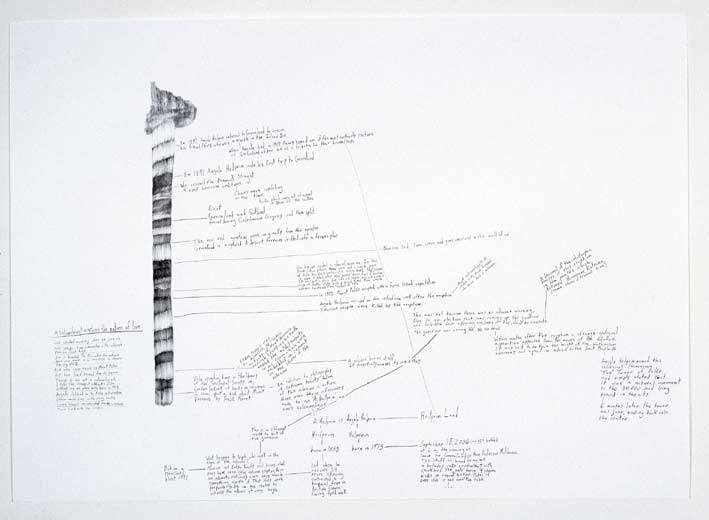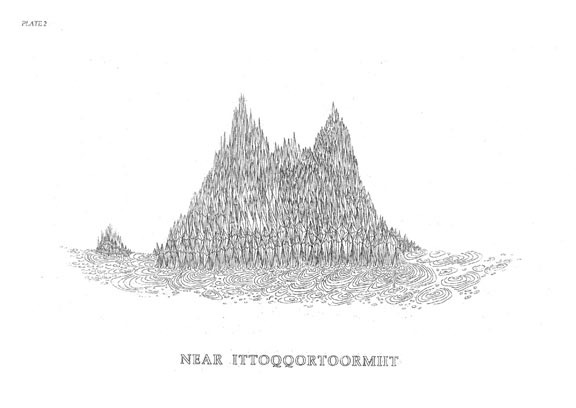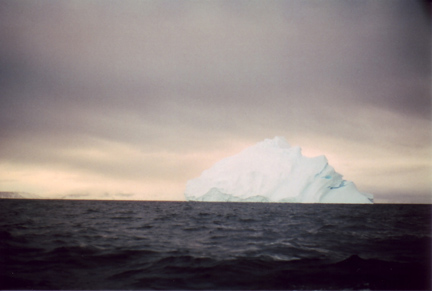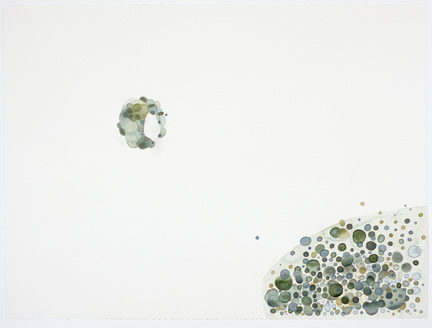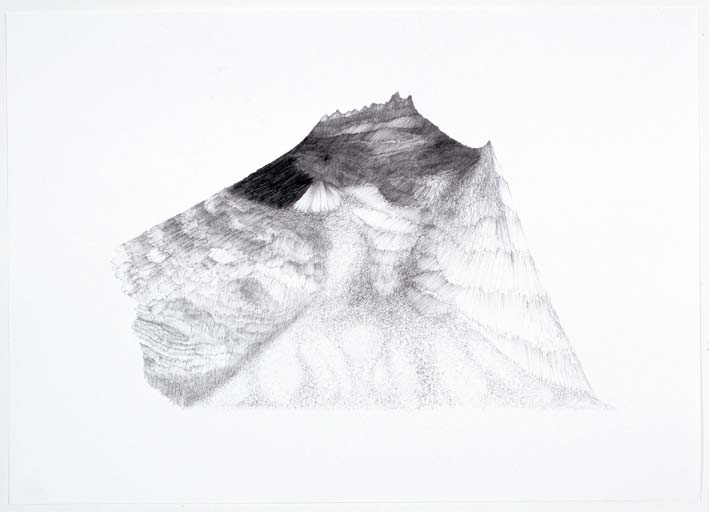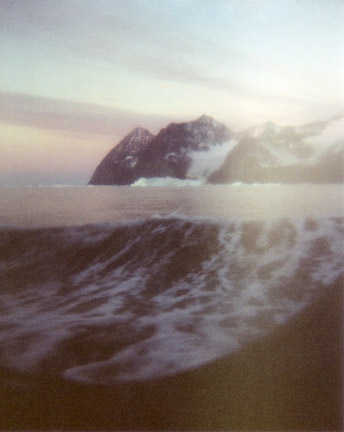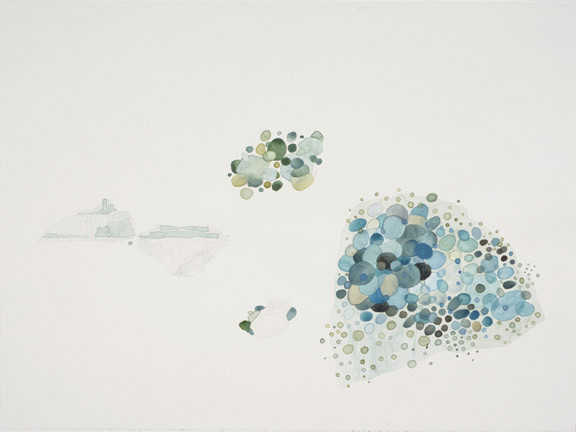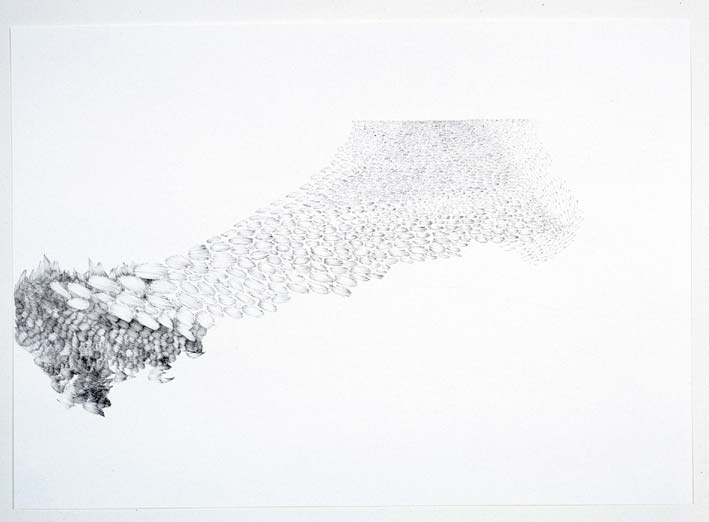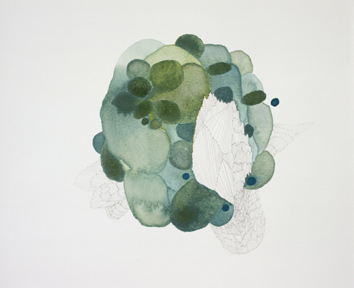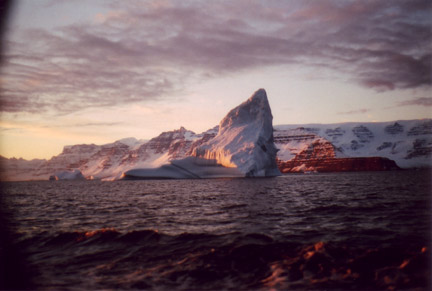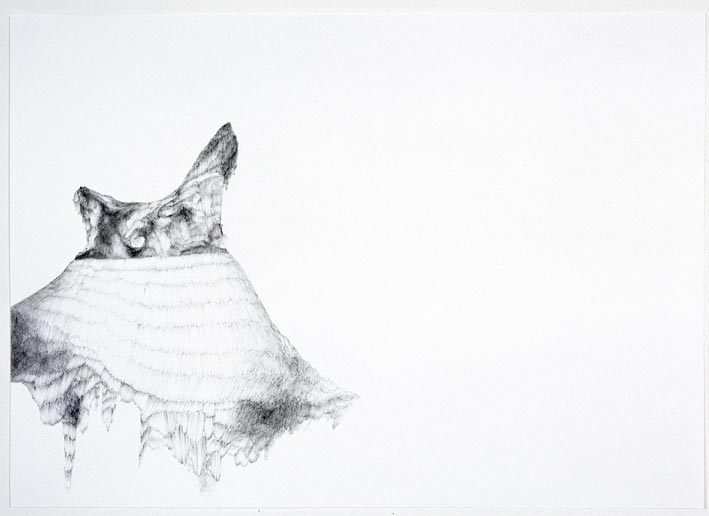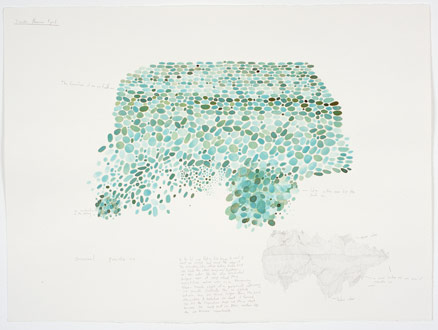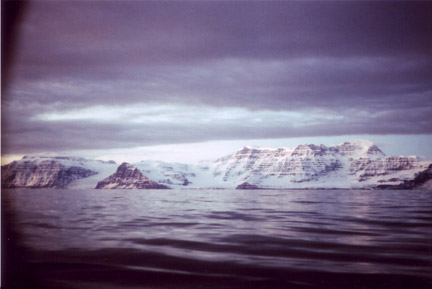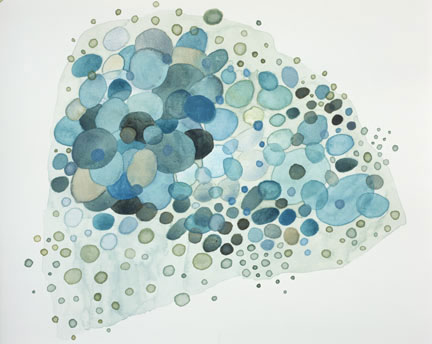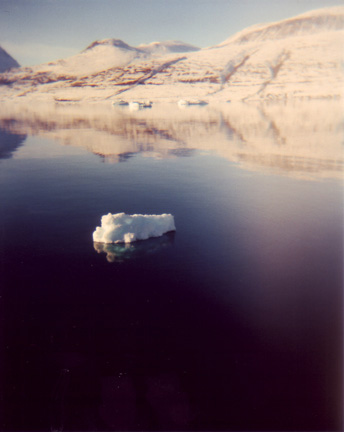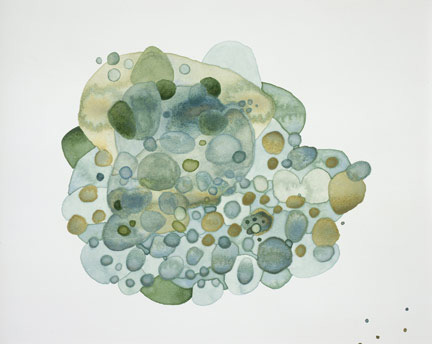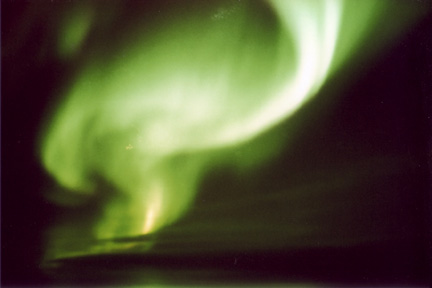TOWARDS HEILPRIN LAND
Work from a voyage to the north east coast of Greenland aboard a ship with Oceanwide Expeditions.
September 18 - September 28, 2006
A new text for the project is located beneath visual material.
Jim said to me, a volcano buries itself.
It perpetually erases its own history.
THE APPROACH
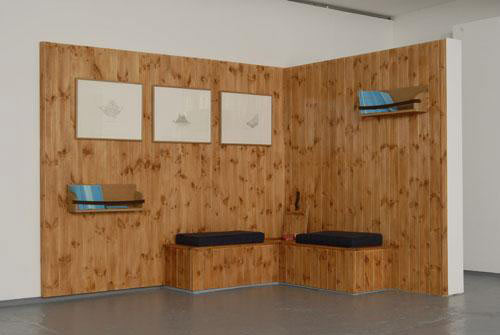
What is the difference between flying over Greenland and approaching by way of water? Before Professor Molchanov, there was only one way I knew that island which inhabits the greater part of the northern map. Greenland was a place to pass over. Between Glasgow and New York. A commuter route. The magnificent occasion of air travel reduced to what you do to go between one place and another.
Passing over Greenland as often as I did, I began to feel that I knew it all too well. Within a few hours after departure from either side of the Atlantic the air would become choppy. Turbulence was always expected and would usually last until we crossed the southern coast of the impenetrable landmass.
There was one exception. In December 1999 we were crossing the ocean east to west.
As we began our approach the captain came over the loudspeaker to announce there would be full visibility - no haze, a complete absence of cloud cover. We would be able to see Greenland. He encouraged us to take advantage.
We rushed around the cabin - side to side, wing to tail, chasing the optimum view. From above, the amount of space allocated to each topographic feature did not piece together as expected. Mountain ranges resembling broken sticks covered in snow would reverse, becoming infinitely larger as we passed over for twenty, thirty, fifty minutes more. I had my camera with me, but no film. Eventually, I rang the flight attendant and explained my situation. Moments later, a voice announced there was an artist on board, in seat 11A, who urgently required film to record the amazing things we were witnessing together. A flight attendant from first class appeared by my side, holding a silver platter with a roll of 800 film and said,
Compliments of the captain’s wife.
Now that I know that island from an intimate distance, there is not a great difference between the aerial and the aqualine perspective. People become addicted to polar terrain. I understand that. For years, every time I passed through Iceland I would spend a whole day with the geyser, waiting for the moment of eruption again and again. Carnal knowledge of a landmass. So beautiful, you break open and melt in. The leap into the volcano.
AN ANECDOTAL HISTORY OF VOLCANOES FROM AROUND THE WORLD
Frank Perret, an early volcanologist, had a habit of monitoring the seismic activity of Mount Vesuvius through clamping his teeth around the metal bedposts in his room, which were embedded in cement on the slopes of the volcano.
During a major volcanic explosion of Mount Pinatubo in June 1991, rumors spread that the volcano was spewing out diamonds. People set about frantically sifting through fallen ash, but the stones proved to be quartz crystals formed by the hardening of magma inside the volcano.
On a diving expedition in 1981, Graham - a geologist specializing in young landmass, had the opportunity to work on Surtsey, an Icelandic island formed in 1963 through an underwater eruption. Graham felt there was something moving about,
The idea of standing on this newly created land.
On one occasion, I had a conversation with a woman who took part in an extreme expedition. During a fieldwork session inside the crater of an active volcano that was filled almost to the brim with molten lava, her heat-sensitive fireproof full body uniform began to incinerate. The field session was put on hold.
Two volcanologists were in a helicopter above an erupting volcano. The crater was completely enshrouded in cloud, so they couldn’t get a clear view of what was happening inside the volcano. Out of nowhere, a tunnel of light opened amidst the clouds, leading straight into the molten crater. The helicopter began flying in a direct trajectory into the tunnel. The volcanologists were thrilled, as they had a perfect sightline into the mouth of the volcano. The pilots on the other hand couldn’t stop screaming. Suddenly, the helicopter spun around and flew full speed ahead out of the tunnel. The volcanologists thanked the pilots for providing such a daring view, but said in the future they did not need such a close proximity for their studies. The pilots responded, we weren’t flying the helicopter; we were being sucked into a vortex by the volcano.
THE TRAGEDY OF MARTINIQUE
Several months ago, at the library of the Geological Society in London, I happened across writings by Angelo Heilprin, an active geologist at the turn of the twentieth century who may also be a distant relative. While he is known for a variety of innovations, his photographs of Mount Pelée, along with those by Frank Perret, remain some of the most beautiful ever taken of an eruption.
On April 23, 1902 Mount Pelée, a seemingly dormant volcano on the island of Martinique, awoke. The volcano became increasingly erratic and talk of evacuation began.
Due to upcoming elections in the city of St. Pierre, residents were forbidden from leaving not only the town, but the island. On May 8th, Mount Pelée erupted with a force beyond all expectation. In almost an instant, virtually all of the 28,000 residents of St. Pierre were dead. There were only three survivors, a cobbler, a young girl and a convict - saved by the thick walls of his cell.
Following this catastrophic event, an astonishing geological phenomenon was witnessed for the first time in human history. The Tower of Pelée, a volcanic obelisk 150 meters wide and 300 meters high, emerged from the crater of the volcano. It was said to be twice the height of the Washington Monument and equal in volume to the Great Pyramids. Upon observation of this geological monument, Angelo Heilprin simply stated it was,
A memorial of nature for the 30,000 dead who are lying buried in the city.
Within a year, the tower was gone, eroding into the depths of the crater.
LOG BOOK. BELOW THE ARCTIC CIRCLE
September 18, 2006
At six in the evening we set off for Scoresby Sund aboard the Professor Molchanov. It was my 33rd birthday. After dinner, the staff on board brought out a birthday cake resplendent with sparklers. A gale force nine storm had kicked in. Plates of cake slid up and down the table. We crossed the Denmark Straight in near hurricane conditions. 48 hours of constant swells in random sequence. It could be like this for another 24 hours. Up to, they say, maybe less. Chairs were coupling on the floor. Lying on their sides, legs in embrace. The books that were not strapped down flew off the shelves. It was good being around people as they sat and talked, even if I was only capable of lying down on a bench. I stayed in the bar, like an albatross keeping a ship company en-route to Antarctica. The din of companionship.
A PERSONAL ACCOUNT OF THE VOLCANO
I went, in 1902 there was this great eruption in Martinique…Mount Pelée. It was, I was practically in tears. Of course I went there for a conference and here we are, volcanologists left and right from all over the world and a crazy thing happened. My batteries went dead, or I ran out of film in my camera, well anyway, I became the guy whose hand was needed for scale in all these shots.
And they were excavating, foolishly, this famous river valley where at the high end of the valley was an insane asylum. And they had these steel chairs that they strapped people to quite clearly, and it was, again one of those things…to see these chairs, well they…no one would allow this to be preserved today because they’d be so embarrassed about it. Because this was a volcano and they just dug it up, there it was. And the other thing is one of the chairs was still there, more or less intact and the other was battered by the pyroclastic flows. And to see that; these are images that are just incredible. Now then, I said they were excavating. They were trying to sort of ‘clean house’ and clean it up, which is always to me a bad sign…So anyway, here they are excavating these pyroclastic flows. They are only about a foot or a foot and a half thick. That amazed me. I thought they would be a meter or two thick. The flows knocked the town flat. These walls this thick are basically gone and the resulting deposit is ankle thick in some spots. That shocked me. I was stupefied. Obviously, the flows were going at high speeds and they had a lot of power. Well, then we came to find out that these guys that are doing all this, wheel barrowing and carting off all this stuff, trying to clean up…they’re finding bones and bodies…and what they’re doing, they’re covering them with plastic bags. So we then discovered, hey, there’s a plastic bag, and we went over to it…and there are these…craniums there of the cooked people.
And so this was too much for us, and I began to touch all these skulls so everybody could take pictures and I’ll tell you it was hard for me because I’m not trained in…that. I can do it but you know I’m not a biologist and so…it was fascinating to see all these pictures and to see that and think about it…something I never thought about, well, what happens to the human brain when it’s cooked and dried out. And here it is, the remaining skeleton.
EULOGY FOR A VOLCANOLOGIST
September 18, 1907
Through the death of Professor Angelo Heilprin, on the 17th of July last, the Franklin Institute lost not only one of its most distinguished members, but also a recognized leader in the search for knowledge.
In the pursuit of his investigations, whether in the fire-scathed ruins of St. Pierre or amid the icy wastes of the frozen north in search of his good friend Peary, Heilprin’s purpose was simply that of the student scientist, whose function is first of all to light the truth.
Angelo Heilprin lived but 54 years, yet within that shortened span he accomplished a work of such large moment as would well suffice the compass of the longest lifetime. Heilprin’s character and the esteem in which he was held by all who were privileged to know him can be summarized by a quotation from Commander Peary’s recent letter.
He wrote,
When I named one of the greatest of Greenland glaciers and later one of the most northerly lands in the world after him, it was no perfunctory action, but a tribute of the deepest regard and friendship.
In 1891 Angelo made his first trip to Greenland, to the west coast.
In 1892 Angelo returned to Greenland to rescue Peary, who was in trouble on the inland ice. I want to go to Heilprin Land.
PARICUTIN
In 1943, high time in the middle of World War II, a volcano was born in a cornfield in Mexico. They named it Paricutin, after the nearest town.
The town of Paricutin was buried under deep ash, and the people who lived there had to leave immediately. This was in the first months after the eruption…The government brought trucks in and they all got on…The government hauled them out to new re-settlement communities that they built for them, and it’s a real hard luck story. Nothing went right. These are the people who cooperated with the government, and the latest indignity, in the mid-1970s they built a prison right outside this town. These people just can’t catch a break.
There is another town, the one with the famous church. You may have seen photographs of it before. The entire town is covered in a thick black lava flow – everything that is, except for the church, which stands like the leaning tower of Pisa, jutting out of the lava, steeple fully intact.
The people in this town, they fought all the way. They didn’t want to leave. They were praying on their parents’ graves when the lava was coming into the town. And finally, very reluctantly, this bishop came by. They had this famous crucifix on the altar. They called it El Señor de Los Milagros, the lord of the miracles, and this was the bishop of the local big city. He came in, he thought there was going to be a catastrophe. The people were going to be there with the city burning down around them. So he took the crucifix off the altar and started marching out of the church, and apparently, people threw themselves in front of him on the ground, and then other people would pull them out of the way and he’d then take another step and then other people would throw themselves in front of him. And it was this dramatic thing and then finally the whole town got behind him and marched for three days to a place of their own choosing, where their own elders had chosen where they were going to go. And then they built a new church to house this El Señor crucifix and it’s now one of the main pilgrimage sites in Mexico…
There was a man known as Dr. Atl, the Renaissance Man of Mexico, who loved Paricutin. He made dozens of paintings of the eruption from the flanks of the volcano.
He set up his easel as soon as the eruption began. He moved out there into a small shack that eventually became buried by the lava flow. He was a philosopher, a poet, a political activist. He was vehemently opposed to the dramatic photographs that were taken of Paricutin as they were long exposures, which was not what you saw when you actually stood and watched the eruption in person. He said,
In the night, the volcano emitted a shower of embers. Most time exposure color photographs taken of this nocturnal spectacle are completely false. Not only because of the excessive chromatic intonation, but also because they present the embers as luminous parabolas, which gives a misleading view of the eruption’s character.
He likened the incandescent fragmentary pieces to the stars.
There are 1000 young volcanoes in the area of Paricutin.
LOG BOOK. NEAR ITTOQQORTOORMIIT
From the deck of a ship in the middle of the North Atlantic I have seen the Aurora Borealis. An internal green-hued glow. Double helixes spinning in the sky. We went to a small town at the mouth of Scoresby Sund, the only one for hundreds of miles in any direction. Streets were paved with rocks and bones. Dogs howl all the time. It is utterly amazing to travel by boat. The water as a solid mass transferring you from one place to another. Stars are brighter here. One moving dot, a plane you could pick out from a million miles away because everything else glitters. Sunrise deep purple and cocoa. Long stretches with smooth water, like a slice of halva. Like poured platinum or mercury. Fluid solids. As in under a microscope when material has plump edges prior to osmosis.
PORTRAIT OF A VOLCANOLOGIST
I am a field geologist, so I’m not a laboratory geologist. I enjoy going into the field, either in Hawaii or on the ships in Japan. I’ve been down in research submarines several times and into big volcanic craters. They look like cliffs, and what you do is go down to the floor of the caldera and then you come up the side of the caldera wall and it’s like coming up the side of a very tall building in Manhattan at night with a flashlight…like coming up in a hot air balloon with a flashlight, so all you see is a small area, and you see the floors, so to speak, the layers going by, it’s really great. I mean it’s fantastic. We go up the cliff, and when I say it’s high…I mean 800,000 feet tall; it’s amazing. You see all these layers and you can make some interpretations of the history of the volcano and how it erupts, so all that is very exciting. So as a field geologist, working on these volcanoes has been very, very fulfilling.
I guess to some extent my interest in volcanology derives from a general interest I had in the out of doors and mountains. As a kid I liked to hike around and part of my life I grew up in Japan actually, so I saw my first volcano in Japan and I climbed Mount Fuji when I was six years old. There is a photo, a family photo of me sitting by a lake sketching the profile of Mount Fuji in the background. That kind of got me interested in the out of doors.
On one occasion a man who’s been working on the Arenal volcano in Costa Rica told me he and a friend had gone up to the top of the volcano following a series of eruptions. Upon reaching the crest, they discovered three new mouths had opened on the volcano. The friend said, I’d like to name one of these craters after you, to which the man replied,
Thank you but that is not an honor I’d like bestowed at this time, as you don’t get that honor until you are dead!
This same man has been recording the sounds of volcanic eruptions for the last forty years.
LOG BOOK. SCORESBY SUND
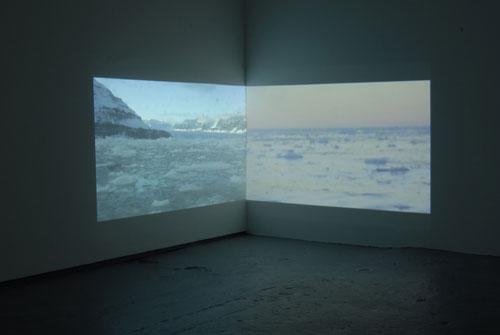
Greenland is getting colder. The Gulf Stream is getting weaker. It is not strong enough to keep the marine convection belt on its assigned route, bringing with it the warmer flow. The walrus are very hungry. Mussels, which they love, thrive in the warmer belt but are dying in the cold. Up to the mouth of a glacier. You feel it inside your lungs. Is this a near sensation to what occurs when you approach an erupting volcano? If poisonous gas is released, your lungs close. It is not possible to gasp for air. A closed valve. We have encountered Musk Oxen and their calves, Harp Seals, Ringed Seals, Arctic foxes, Arctic Hares, Polar Bear prints.
The last expedition in late August encountered fifty polar bears in ten days. This is not normal. They are starving on the ice.
LOG BOOK. THE MORAINE
The New Red Mountains were originally located at the equator. A desert terrain drifted north into a frozen place. East Greenland and Scotland formed during Caledonian Orogeny (when mountains smash together and join into one). Then they split. Is this why I feel so at home here? One day we visited a glacial moraine. In this particular place, there was not a single sign of life. No tiny roots, no cracked bones. The longer we remained there the more terrified I became. It was not a place for life as there was not a trace of death. Only high pitched time. Time which carves mountains. Time devoid of life.
THE EMPEDOCLES COMPLEX
In 1831, an island named Ferdinandea appeared off the southern coast of Sicily, sparking an international dispute over territorial ownership of this strategically positioned heap of young geology. Before any serious conflicts developed, the island disappeared, crumbling back into the sea.
Not long ago, I had the opportunity to view Ferdinandea under a microscope in the geology department of the Hunterian. One of only two mineral samples that remain of this island was being housed between two glass slides, a fifteen-minute walk from my apartment. To look, at an atomic level at an island that no longer exists.
In daily life, it is impossible to have unmediated contact with geothermally sourced heat; as to do so would be to incinerate. To make more intimate sense of this phenomenon, I boiled a small pan of milk in a 100 degree Celsius sulfur spring in the crater of an active volcano. To monitor seismic activity, Frank Perret used his teeth.
A section of Greenland is named after Angelo Heilprin as a tribute to the time he set out on a rescue mission and brought his good friend to safety from that frozen terrain. There are different approaches to dealing with a potential catastrophe. For Heilprin, whether on the crest of a volcano or in a frozen wasteland, the impetus to take action at the edge of the abyss was always the same.
LOG BOOK. NANSEN FJORD
September 25, 11:02am
We traveled through the pack ice in truly un-chartered waters with hitherto, no known depth. Only one line had been drawn. For several days, I lost the desire to speak. Watching the tops of mountains; deep rust, burnt crimson. As if they had been ripped apart. Evidence of a landslide. Bigger than most buildings. In front of this event that could have taken place one million years ago or yesterday, my eyes blind with tears. The life span of my father is not close to one second in relation to geological time. He died within the life span of an iceberg.
TOWARDS HEILPRIN LAND
A geologist said to me,
Geological time…I think about it every day. You know, I think about my own life, my dad passed away about a year ago and so here, I knew him since, obviously I was born and you are very aware of the finite kind of nature of our lives and how short they are. But then again, you see an ant, you say, wow, there’s a creature that’s around this tiny window and they’re going about their business and they function. Ours is this length…we’re really pretty lucky as an organism. And we have health; we have a lot of great things. People, I think, forget how lucky we are. And I’ve been lucky. My boss was a very close friend of this guy who was killed at Mount St. Helens.
He was watching the volcano with an instrument that my advisor and his advisor, who’s now dead, specialized in using. And they got this guy using it and he was there sitting with it when he was killed. You know, by the way a friend of mine was scheduled to be there that day when it happened and he had a wedding that came up, and he died later in another volcano. But the point is, that people confronting these levels of danger are taking much more of a risk, and my old advisor says now, you know we took more risks then we really should have. We should have been more careful. The book Volcano Cowboys is about this…How great a risk do you take? You know about the Galeras thing? Galeras was a volcano in Columbia that people had a meeting at to go and study, and it’s a longer story than that, but to cut to the chase, more than a dozen scientists were in the crater and they…most of them died.
A volcanologist explained the nature of love to me. He said,
You love what you get to know, what you pay attention to and therefore become more aware of. This is not a passive form of love. This is how I feel about Arenal. Now, after forty years, I don’t need to see the volcano to know that I love it, just as I don’t need to see my daughters often to know that I love them. Just to know they are there and happy and doing as they should is enough.
IN MEMORY OF JIM LUHR, GEOLOGIST
I recently learned Jim Luhr, the Director of the Global Volcanism Program since 1995, passed away unexpectedly on January 1st, 2007 at the age of 53. Though I did not know him well, our conversations were deeply affecting. He had a great love of Paricutin and implicitly understood my connection to Eldfell. His generosity and help enabled this project to come into fruition. This project is dedicated to his memory.

